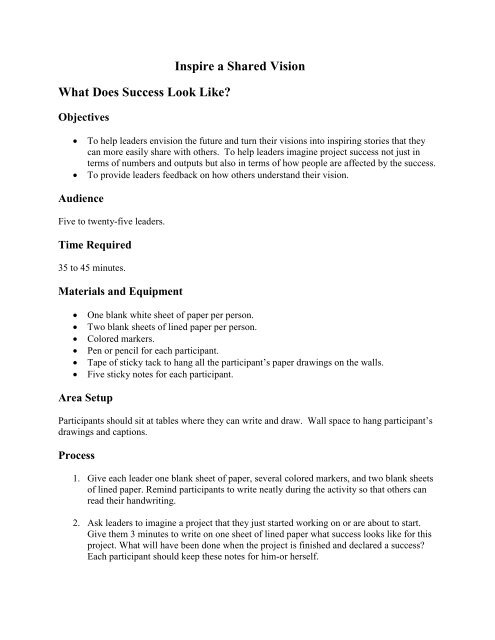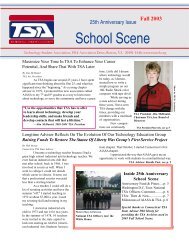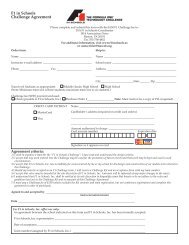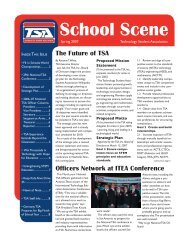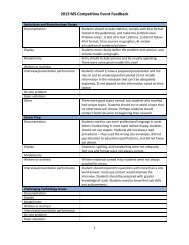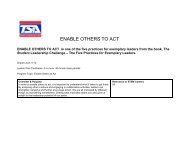Inspire a Shared Vision What Does Success Look Like?
Inspire a Shared Vision What Does Success Look Like?
Inspire a Shared Vision What Does Success Look Like?
Create successful ePaper yourself
Turn your PDF publications into a flip-book with our unique Google optimized e-Paper software.
<strong>What</strong> <strong>Does</strong> <strong>Success</strong> <strong>Look</strong> <strong>Like</strong>?<br />
Objectives<br />
<strong>Inspire</strong> a <strong>Shared</strong> <strong>Vision</strong><br />
• To help leaders envision the future and turn their visions into inspiring stories that they<br />
can more easily share with others. To help leaders imagine project success not just in<br />
terms of numbers and outputs but also in terms of how people are affected by the success.<br />
• To provide leaders feedback on how others understand their vision.<br />
Audience<br />
Five to twenty-five leaders.<br />
Time Required<br />
35 to 45 minutes.<br />
Materials and Equipment<br />
• One blank white sheet of paper per person.<br />
• Two blank sheets of lined paper per person.<br />
• Colored markers.<br />
• Pen or pencil for each participant.<br />
• Tape of sticky tack to hang all the participant’s paper drawings on the walls.<br />
• Five sticky notes for each participant.<br />
Area Setup<br />
Participants should sit at tables where they can write and draw. Wall space to hang participant’s<br />
drawings and captions.<br />
Process<br />
1. Give each leader one blank sheet of paper, several colored markers, and two blank sheets<br />
of lined paper. Remind participants to write neatly during the activity so that others can<br />
read their handwriting.<br />
2. Ask leaders to imagine a project that they just started working on or are about to start.<br />
Give them 3 minutes to write on one sheet of lined paper what success looks like for this<br />
project. <strong>What</strong> will have been done when the project is finished and declared a success?<br />
Each participant should keep these notes for him-or herself.
3. Have each leader imagine he or she was to use a camera to take a snapshot of the most<br />
successful moment of the project. Tell leaders to think about what and who is in the<br />
picture; include at least one person in the picture. <strong>What</strong> are the people doing, saying or<br />
feeling? When and where is this event happening?<br />
4. Give leaders 10 minutes to draw pictures of the snapshots they imagined on the blank<br />
sheets of paper. Remind everyone that the quality of drawing doesn’t matter at all; this is<br />
just a different approach to help them explore their visions.<br />
5. Have leaders take the second blank sheers of lined paper and write short captions for the<br />
pictures. Tell them to briefly answer who, what, when, where, and why in their captions.<br />
6. Designate the location of the “vision gallery” and ask participants to hang their vision<br />
pictures around the room with their captions beneath.<br />
7. Invite all participants to visit the “vision gallery.” Ask: “<strong>What</strong> did others include in their<br />
visions that you might want to add to yours?” Ask each participant to leave a comment<br />
written on a sticky note for each of the other five pictures. Suggest that the comment<br />
relate to something unique or practical about the vision. Have them post their notes on the<br />
lined caption page that is below each picture.<br />
8. Leave the gallery up as long as you like. Sometimes participants like to explore the<br />
gallery on another break. At the end of the session, have each artist take his or her<br />
original vision, caption, and all the sticky comments.<br />
9. Suggest that participants may want to review the sticky note comments and add to or edit<br />
their visions based on the comments they received and/or what they noticed from looking<br />
at the other visions.<br />
10. Encourage leaders to later return to their project teams and take the opportunity to<br />
describe what success looks like on the project using the pictures they drew, the captions,<br />
and the comments as a guide. Tell them that they do not need to actually show anyone<br />
the pictures, but they should go beyond describing just the numbers and logistical details<br />
of a successful project. It should include how people are involved and what they are<br />
saying and feeling. This can help all members of their teams feel more connected to their<br />
visions and more likely to work to achieve them.<br />
Source: The Leadership Challenge Activities Book, Wiley Publishing


